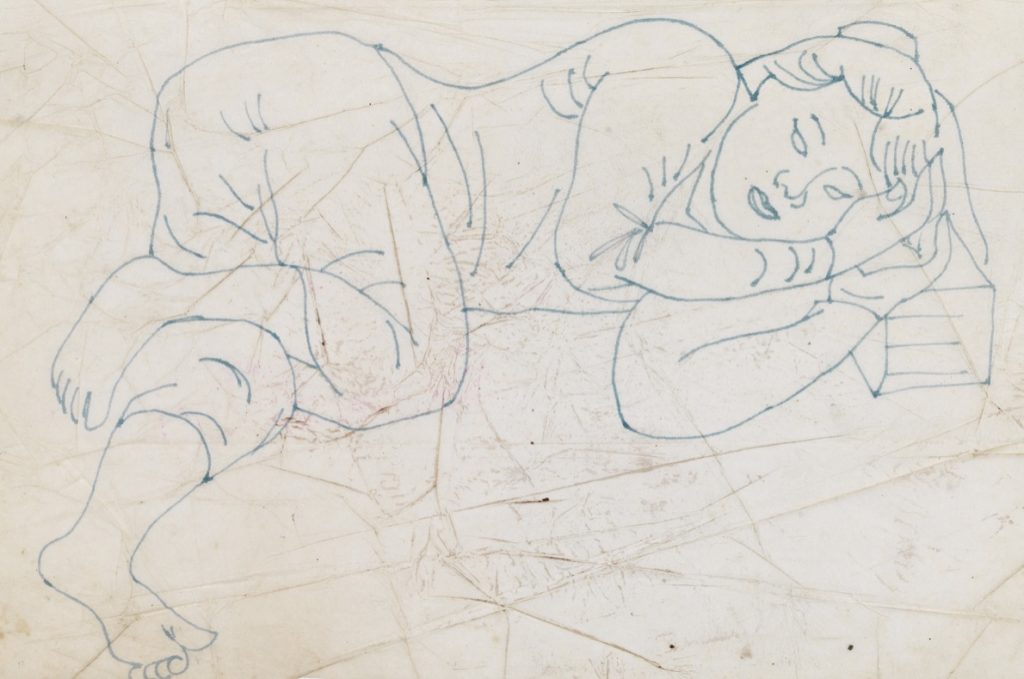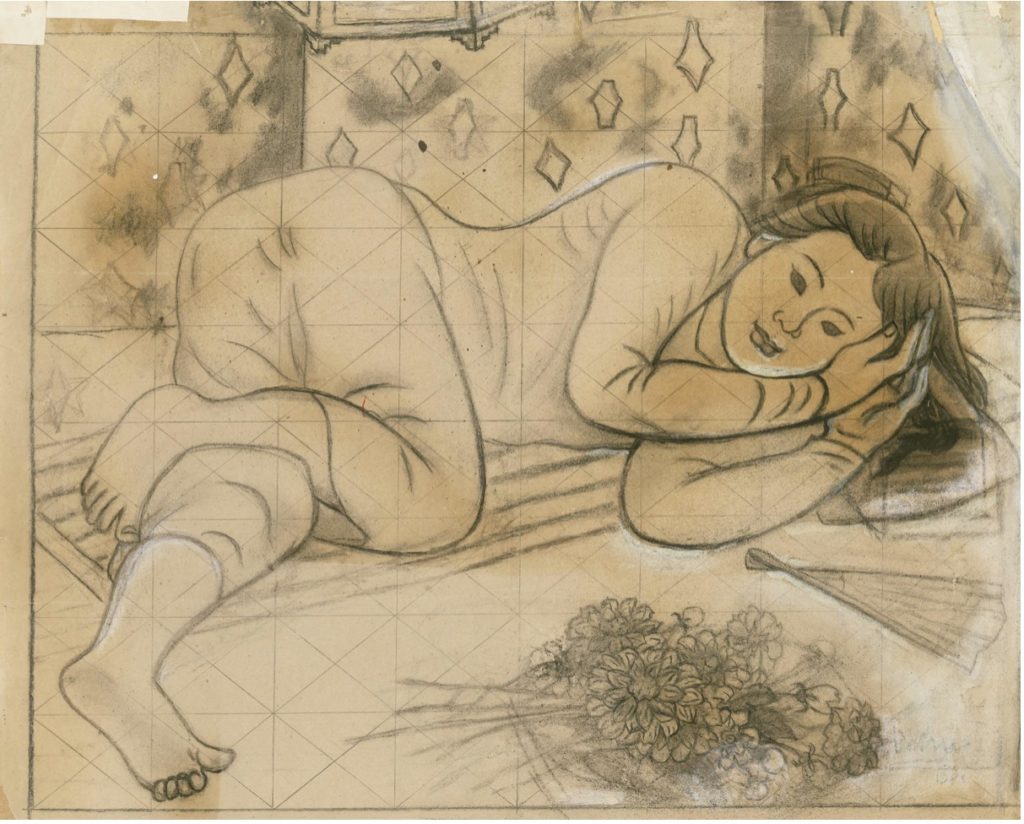Hoang Tich Chu, 1981, « The Young Woman At Rest », or ambiguity necessarily caught up by ambivalence
Our lacquer on panel signed and dated “htchu 1981” (lower right) is presented with other works by the same artist.
A mixed technique on paper, also signed and dated “htchu 1981” lower right (both works are the same size (42 x 52 cm)).
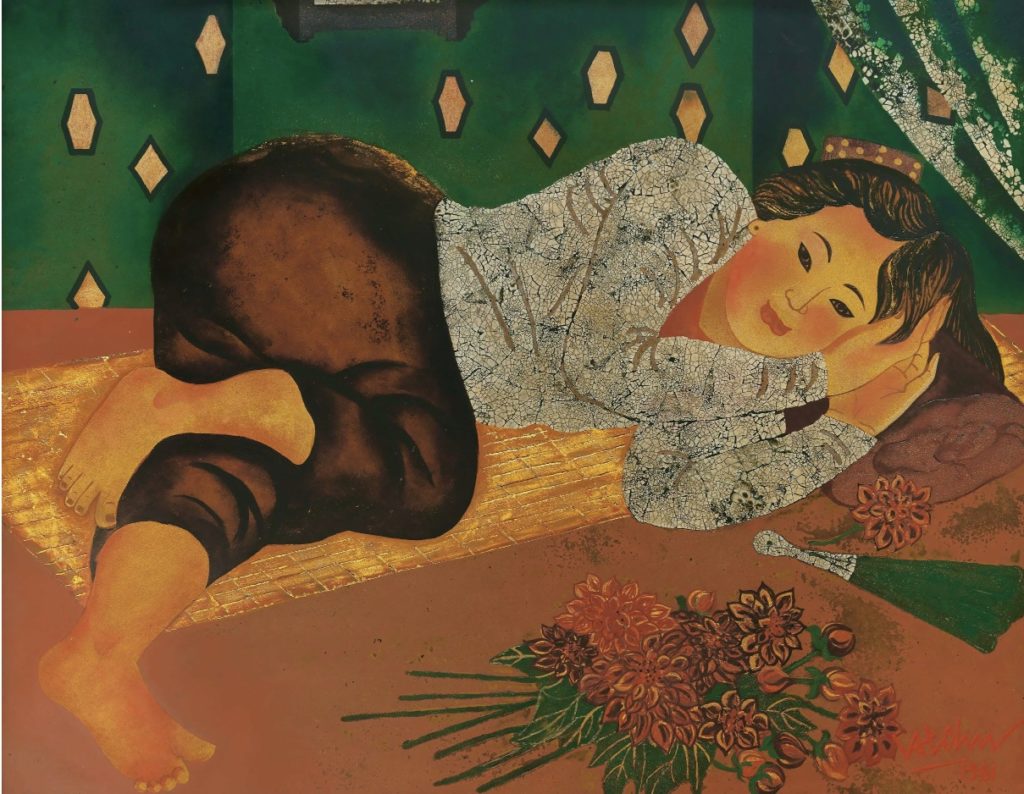
And a smaller ink on paper and pencil (16 x 24 cm), undated and unsigned, but which stylistically can be dated to the same year, 1981.
The ensemble not only illustrates the extraordinary talent of one of Vietnam’s greatest lacquer artists, but also provides more detailed technical and aesthetic information.
In terms of technique, we have a better understanding of the way Hoang Tich Chu and the lacquer painters of his time approached their work.
The first step is to draw a sketch on paper in ink and pencil, outlining the character, composition and proportions.
Next, the subject is sketched in pencil and charcoal on tracing paper squared to the exact dimensions of the work to come. The tracing paper is then used to reproduce the drawing on the panel to be lacquered.
The work is precise and meticulous, from black and white to a symphony of colors, driven by the subtle pigments of lacquer.
A comparison between these three works reveals the different stages of execution.
While the artist adheres strictly to the initial position of the woman reclining on her mat, the shape of the pillow has become rounder, the mat more precise, and appear a diamond-patterned partition, a hanging, a fan, a bouquet of flowers and an isolated flower.
The artist applies eggshell, in a triangular pattern, to the woman’s tunic, the handle of the fan and the hanging, illuminating the young woman’s face.
Still to come are the lacquer colors, the result not only of the pigments used but also of their evolution with the rhythm of their application and the environment. Alix Aymé, whose words we never tire of reproducing (L’Illustration, 1949), was so taken with this uncertainty:
“Such a magnificent material, such a prodigious marvel of perfection and brilliance presupposes, whatever the tone of the artists who created it, a patient submission to its demands. If there is one technique that demands of the painter a gift of himself, it is lacquer.”
From an aesthetic point of view, it is important to note – and this is exceptional in his work – that the artist does not use as a model the unconditional love of his life, his wife, the mother of their 7 children, Hoang Tuyet Trinh (1918-2012). The painter fell head over heels in love with this beautiful young woman he met on Hang Bac Street in Hanoi. He married her the same year he was admitted to the Ecole des Beaux-Arts d’Indochine in the 11th graduating class (1936-1941).
We see her here in Hanoi in 1940.
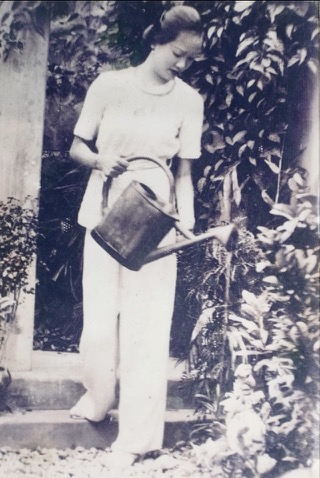
She was always there for him, devoted and energetic, helping him to set up his studio in Hanoi, following him to Ha Bac province during the war of independence and joining the Vietminh with him. She gave him 7 children.
Through the painter’s work, she appears as a paragon of beauty and elegance: distinguished, refined, radiant in flamboyant ao dai, as can be identified in the lacquer (50X35 cm) dated 1960, below:
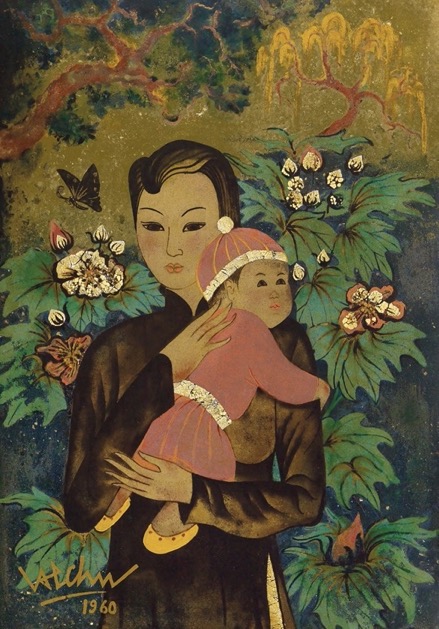
Here, the young woman is a different person: her facial features are unknown to us, even during the execution; we can see a rapprochement towards the features of the wife. Above all, her body appears more massive. An aesthetic choice that the painter’s family explains by a trip to Poland, a “brother-communist” country in 1955. The painter returned fascinated – among other things – by the corpulence of the women, in stark contrast to that of Vietnamese women. Hoang Tich Chu kept a photo of himself (below, in Warsaw, 1955), surrounded by women he considered “round”. He liked to show it to his visitors, delighting in the exotic differences, in this case morphological, with his native Vietnam. Note how these Polish ladies embrace our somewhat… rigid painter.
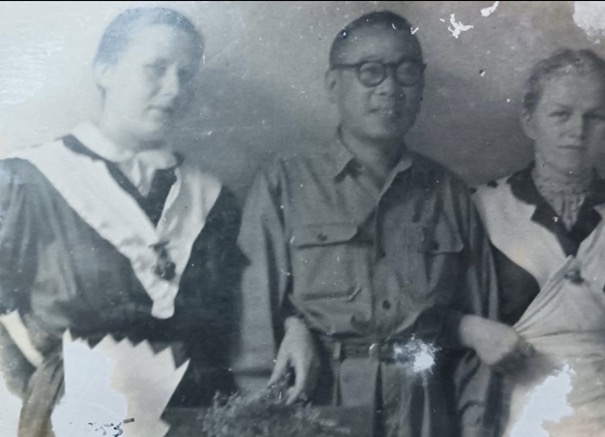
Our young woman departs from the classic canons of the distinguished Hanoian woman, a little distant, in ao dai. She is dressed simply, relaxed, unfolding her left leg, her foot filling the lower left corner of the work. Her face, with red cheeks, expresses not the usual haughty seduction of the generic women of Le Pho, Vu Cao Dam, Mai Thu, for example, but a kind of vulnerability. Her lipstick, made-up eyes and plucked eyebrows convey an almost shy coquetry, supported by the nail varnish on her fingers and toes and the pink hair clip, mentioned by the painter in his very first sketch.
The background features 11 decorative elements, including 3 lozenges if we accept the semi-hidden one on the left.
A wooden lantern, fixed to the wall, with only the bottom visible, watches over her as she reclines on a bed whose hardness is softened by a fine mat.
His head is propped up on a pillow, the shape of which the painter altered between his original drawing and the final description: a comfortable roundness prevailed over cubic firmness. This can be seen “live” in the second version.
A bouquet of dahlias occupies the foreground. One of the flowers has been detached. Note that neither the bouquet nor the flower appear in the preliminary composition. The isolated flower is even absent from the intermediate work. A late addition, all the more surprising given that the dahlia is rarely found in the Vietnamese repertoire. This hoa thược dược (“fast-growing flower”) symbolizes founding love. Both the flowers and the fan are at a distance from the young woman, incongruous because they have no immediate use. Has the young woman just received the bouquet, or extracted just one flower to breathe into it? Her face, with its flushed cheeks, seems to be struggling to hide her emotion.
Hoang Tich Chu painted this lacquer in the beautiful French colonial house he has been living in since 1956, designed by French architect Lagisquet. From this 13 de la voie 255, you can walk along the Ngô Sy Liên market, past the train station and through the Temple of Literature: more than places, presences in this magical Hanoi.
Our lacquer reflects a confrontation between ambiguity and ambivalence. How does Hoang Tich Chu feel?
In 1981, 9 years had passed since one of his sons was killed in action in Quang Tri and since Hanoi was bombed, 6 since “reunification”, 3 since the invasion of Cambodia against the Khmer Rouge, 2 since the Chinese response was halted not far from Hanoi.
In December 1980, the first constitution of the “Socialist Republic of Vietnam” was promulgated. Article 2 declared the country to be a “State of Dictatorship of the Proletariat”… But the following year, in March, the 5th Congress of the Vietnamese Communist Party questioned the country’s economic management.
What assessment does he, the son of Hoàng Tích Phụng – former governor and one of the protagonists of the Đông Kinh Nghĩa Thục in 1907- draw from his life?
Do the painter and the man see eye to eye?
He, the younger brother of the journalist of the same name, he, the older brother of playwright Hoang Tich Linh, doctor Hoang Tich To and screenwriter Hoang Tich Chi, from such a brilliant family where everything is questioned, even a political cause, does he reveal himself to be an ambiguous artist or an ambivalent man?
Ambiguity is the duality or plurality of possible meanings. “A halo of meaning in the night of reality“, as André Comte-Sponville calls it.
Ambivalence is a duality, an opposition of real values or feelings. A possibility versus an opposition.
Our “Jeune femme” doesn’t make a choice.
The greatness of an artist is to deliberately confuse meaning and feeling, to refuse the choice between possibility and reality.
It is in this way that we must accept their betrayals, their wavering memory.
How can we fail to believe that Hoang Tich Chu, who was forced to burn his work 25 years ago as “decadent bourgeois”, is not throwing a bottle into the sea with this lacquer?
When ambiguity is overtaken by ambivalence: value versus meaning.
Jean-François Hubert
